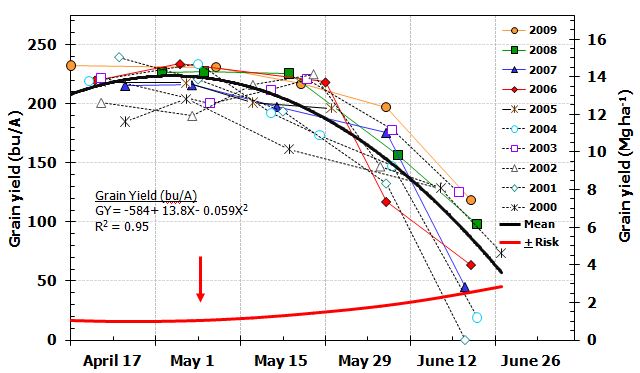May 6, 2010
Field Crops 28.421 - 77
The Risk in Early Planting Dates
Joe Lauer, Corn Agronomist
As of May 2 about 51% of the corn crop acreage was planted. With the
exception of the eastern 1/3 of Wisconsin, most farmers have finished
corn planting and have moved on to planting soybean. USDA-NASS began
keeping records in 1979 on various stages of crop progress during the
growing season. This season is the earliest we have ever hit the 50%
mark for corn acreage planted.
Grain harvest and fall work was delayed at the end of the 2009
production season and growers were thankful for the warm spring to
catch up with much of this work. I heard of some farmers that started
planting the 2010 crop before they were done harvesting the 2009 crop!
Our standard recommendation is to plant corn anytime field conditions
are conducive after April 20 in southern and after April 30 in northern
Wisconsin. If you can plant all of your corn on one date, then the best
date is May 1 in southern and May 7 in northern Wisconsin. Earlier
planting must take into account soil temperature and insurance policies.
Corn growth occurs anytime temperatures are above 50 degrees.
Even though corn planting finished early, some farmers are looking over
their shoulders and are anxious about the risk of planting so early. We
have been collecting planting date response data since 1974. Figure 1
shows the last 10 years of data for Arlington, WI. The optimum date to
plant corn at Arlington is May 1. There are some years (2002 and 2003)
where the May 1 planting date was lower yielding than adjacent planting
dates. Usually, planting earlier or later than May 1 in many years will
decrease grain yield. But any early yield decreases are made up by lower
drying costs at the end of the growing season. Later planting dates not
only decrease yield, but also result in higher drying costs due to
greater grain moisture at the end of the growing season.
Evaluating the risk of earlier planting date is done much like
analyzing trends in the market. We are most interested in the grain
yield of a planting date decision (mean), but we also need to know the
variance, skewness and kurtosis of points surrounding the mean. These
statistical terms basically refer to the "pattern" of the points around
the mean. Figure 1 shows an estimate of variance (or "spread") of the
points around the mean called the standard deviation. From April 17 to
May 7 the standard deviation is
+ 15 to 20 bu/A. Standard deviation begins to increase on May 7 and later increases
to nearly + 45 bu/A by
June 19, which is almost equal to the mean. In other words, if you
planted full-season corn on June 19 you would most likely produce somewhere between 0 and 95 bu/A.
Skewness is an estimate of the likelihood a decision will be
"positive/upside" or "negative/downside". For the planting date
decision, as planting is delayed there is a significant, but weak
downside risk with delayed planting. In other words, there is a slightly
greater likelihood that planting dates will be more negative as planting
is delayed. So again, you are better off planting closer to the optimum
date.
Kurtosis is an estimate of the frequency of "extreme" environments. The
pattern of the points in the graph below visually show this in that in
that grain yield ranges from about 180 to 230 bu/A on May1, while the
range around June 12 is from 0 to 130 bu/A. A significant, but weak
increase in the frequency of extreme environments occurs as planting is
delayed. Some years you could plant a full-season hybrid late and get
some yield, but other years you could plant late and get nothing.
Risk on planting dates prior to May 1 is similar to planting dates after
May1 through about May 15. After which risk begins to significantly
increase and the decision will likely be negative and have more extreme
yields.
One of the characteristics of a high producing or record year is that
the year begins with early planting of corn. We need early rains to
activate herbicides. There are always exceptions, but we set ourselves up
for a good production season by getting the corn crop
planted and emerging as early as possible.
Figure 1. Grain yield response of full-season corn planted on
various dates at Arlington, WI. The optimum date to plant corn is May 1.
Risk is defined as the standard deviation (i.e. spread) of the points
along the mean.
